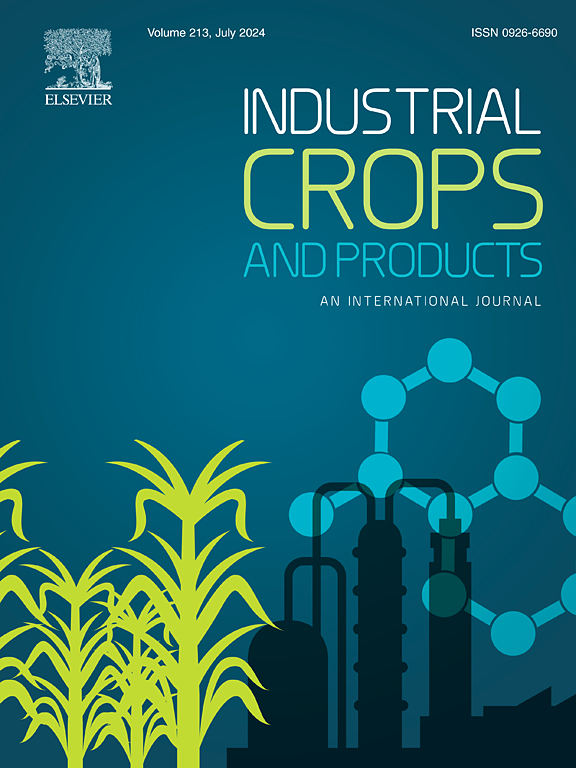Investigation of the inhibitory effects of borneol essential oil on Malassezia furfur and inflammatory factors in HaCaT cells: A molecular docking approach
IF 5.6
1区 农林科学
Q1 AGRICULTURAL ENGINEERING
引用次数: 0
Abstract
Background
The essential oil derived from the leaves/branches of Cinnamomum camphora (L.) Presl contains major chemical constituents, including d-borneol, camphor, and limonene, which possess notable medicinal properties.
Objective
To assess the anti-dandruff potential of borneol essential oil (BEO).
Methods
The antifungal activity of BEO against Malassezia furfur was evaluated. Its mechanism of action was explored using molecular docking, along with exogenous ergosterol and sorbitol supplementation and nucleic acid leakage assays. Network pharmacology, combined with molecular docking, predicted the anti-inflammatory mechanisms of BEO. At the same time, RT-qPCR was used to assess the effects of this treatment on the expression of inflammatory factors in HaCaT cells.
Results
The minimum inhibitory concentration (MIC) of BEO against Malassezia furfur was 18.75 μL/mL. Exogenous sorbitol increased MIC to 37.50 μL/mL, while ergosterol had no effect. Nucleic acid leakage assays showed a significant rise in extracellular nucleic acid levels following BEO treatment (p < 0.05), indicating disruption of cell wall biosynthesis and membrane integrity. Molecular docking demonstrated strong binding interactions between BEO constituents and key proteins, CYP51 (membrane) and Malf1 (cell wall), of Malassezia furfur, with binding energies reaching up to 15.06 kJ/mol. Network pharmacology identified PPARG, EGFR, and ESR1 as core anti-inflammatory targets, with binding energies reaching 26.78 kJ/mol. BEO significantly downregulated mRNA expression of IL-6, IL-1β, and TNF-α in LPS-stimulated HaCaT cells (IL-6 reduced by 25 %–45 % compared to LPS control).
Conclusion
This study elucidates the dual anti-dandruff mechanisms of BEO through inhibition of Malassezia furfur growth and attenuation of skin cell inflammation, offering theoretical support for its application in cosmetic formulations.
冰片精油对毛马拉色菌及HaCaT细胞炎症因子抑制作用的分子对接研究
从樟树(Cinnamomum camphora, L.)的叶子/树枝中提取的精油。Presl含有主要化学成分,包括d-冰片,樟脑和柠檬烯,具有显着的药用特性。目的评价冰片精油(BEO)的去屑潜能。方法评价BEO对马拉色菌的抑菌活性。通过分子对接、外源麦角甾醇和山梨糖醇补充和核酸泄漏试验探讨其作用机制。网络药理学结合分子对接,预测了BEO的抗炎机制。同时,采用RT-qPCR方法评估该处理对HaCaT细胞炎症因子表达的影响。结果BEO对马来色菌的最低抑菌浓度(MIC)为18.75 μL/mL。外源山梨醇使MIC升高至37.50 μL/mL,麦角甾醇无影响。核酸泄漏试验显示,BEO处理后细胞外核酸水平显著升高(p <; 0.05),表明细胞壁生物合成和膜完整性受到破坏。分子对接表明,BEO组分与马拉塞菌的关键蛋白CYP51(膜)和Malf1(细胞壁)之间存在较强的结合作用,结合能可达15.06 kJ/mol。网络药理学鉴定PPARG、EGFR和ESR1为核心抗炎靶点,结合能达到26.78 kJ/mol。BEO显著下调LPS刺激的HaCaT细胞中IL-6、IL-1β和TNF-α的mRNA表达(与LPS对照组相比,IL-6减少了25 % -45 %)。结论本研究阐明了BEO通过抑制毛马拉色菌生长和抑制皮肤细胞炎症的双重去屑机制,为BEO在化妆品配方中的应用提供了理论支持。
本文章由计算机程序翻译,如有差异,请以英文原文为准。
求助全文
约1分钟内获得全文
求助全文
来源期刊

Industrial Crops and Products
农林科学-农业工程
CiteScore
9.50
自引率
8.50%
发文量
1518
审稿时长
43 days
期刊介绍:
Industrial Crops and Products is an International Journal publishing academic and industrial research on industrial (defined as non-food/non-feed) crops and products. Papers concern both crop-oriented and bio-based materials from crops-oriented research, and should be of interest to an international audience, hypothesis driven, and where comparisons are made statistics performed.
 求助内容:
求助内容: 应助结果提醒方式:
应助结果提醒方式:


